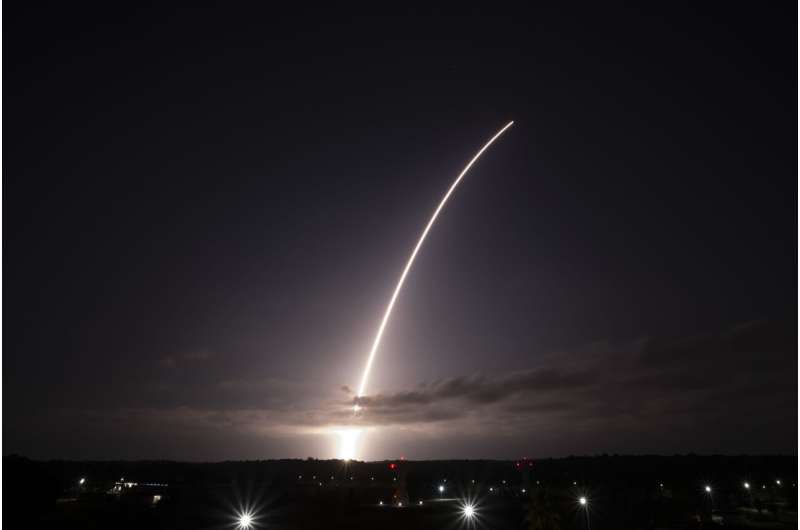
Sentinel-2C launched into orbit on 5 September at 03:50 CEST (4 September 22:50 local time) and separated from the Vega rocket at approximately 04:48 CEST.
Around 14 minutes later, at 05:02 CEST, ESA received the all-important signal indicating that the satellite was safely in orbit.
Constantin Mavrocordatos, Sentinel-2 Project Manager at ESA, said, “I am overjoyed with the successful launch of Sentinel-2C, a milestone that would not have been possible without the dedication and hard work of our incredible team. Together, we’ve taken another significant step forward in advancing Earth observation and supporting critical applications that benefit our planet.”
ESA’s Director of Earth Observation Programmes, Simonetta Cheli, commented, “We are thrilled to celebrate the successful launch of Sentinel-2C, a new milestone in the well-established collaboration between ESA and the European Commission.
“This mission further confirms the role of Copernicus as a leading program to contribute to climate change and environmental challenges worldwide, but also ensures the continuity of vital data to support agriculture, forestry, maritime monitoring, and for many other sectors. Together, we are solidifying Europe’s commitment to a sustainable future, empowering decision-makers with the tools they need to protect our planet.”
ESA’s Director of Space Transportation Toni Tolker-Nielsen, said, “Europe’s Vega rocket launched the previous two Sentinel-2 satellites in 2015 and 2017, so this launch was a fitting farewell to a very successful rocket.
“Teams are already preparing for the next Vega launch, the upgraded Vega-C by the end of the year. Today’s liftoff was Vega’s 20th successful launch in its 12 years of service, farewell Vega, long live Vega-C!”
About Copernicus Sentinel-2
The Copernicus Sentinel-2 mission provides high-resolution optical imagery for a wide range of applications including land, water and atmospheric monitoring. The mission is based on a constellation of two identical satellites flying in the same orbit but 180° apart: Sentinel-2A and Sentinel-2B. Together, they cover all of Earth’s land and coastal waters every five days.
With Sentinel-2C now in orbit, it will soon replace its predecessor, Sentinel-2A, following a brief period of tandem observations. Sentinel-2D will eventually take over from Sentinel-2B. Later, it is planned that the Sentinel-2 Next Generation mission will then ensure data continuity beyond 2035.
The current Sentinel-2 satellites each carry a high-resolution multispectral imager that generates optical images in the visible, near-infrared and shortwave-infrared part of the electromagnetic spectrum. From their altitude of 786 km, they provide continuous imagery in 13 spectral bands with resolutions of 10 m, 20 m and 60 m, with a large swath width of 290 km.
Sentinel-2 data are currently being used for a broad range of applications, including agriculture, water quality monitoring, natural disaster management, including wildfires, volcanic eruptions and floods. The mission has surpassed its original expectations, for example, by demonstrating its ability in detecting methane emissions.
For agriculture, the mission helps to monitor crop health, predict yields and enable precision farming. Images are used to detect crop type, and to determine biophysical variables such as leaf area index, leaf chlorophyll content and leaf water content to monitor plant growth and health.
The Sentinel-2 mission is the result of close collaboration between ESA, the European Commission, industry, service providers and data users.
ESA develops, builds, launches and operates the satellites in orbit, and downloads the scientific data.
Sentinel-2 data are freely available via the Copernicus Data Space Ecosystem, providing instant access to a wide range of data from both the Copernicus Sentinel missions and the Copernicus Contributing Missions.
The Sentinel-2 satellites have been designed and built by a consortium of around 60 companies led by Airbus Defence and Space.
The Copernicus component of the EU Space Program is supported by a set of dedicated satellites, known as the Sentinel family, and contributing missions (existing commercial and public satellites). Looking to the future, six Sentinel Expansion missions and four Next Generation Sentinels are being developed to address EU policy and gaps in Copernicus user needs.
About Vega
Sentinel-2C was the last liftoff for the Vega rocket. After 12 years of service—this was the final flight—the original Vega is being retired to make way for an upgraded Vega-C.
Other missions launched by the small and nimble rocket over its lifetime are flagship ESA missions such as technology demonstrator Proba-V, wind monitoring satellite Aeolus, the reentry vehicle IXV and LISA Pathfinder, a forerunner to LISA that will measure gravitational waves in space.
The Vega line ensures that Europe has a versatile, independent access to space, complementing the Ariane family of rockets to launch satellites to any orbit—continuing with Vega-C and the heavy-lift rocket Ariane 6.
Citation:
Sentinel-2C joins the Copernicus family in orbit (2024, September 5)
retrieved 6 September 2024
from https://phys.org/news/2024-09-sentinel-2c-copernicus-family-orbit.html
This document is subject to copyright. Apart from any fair dealing for the purpose of private study or research, no
part may be reproduced without the written permission. The content is provided for information purposes only.







